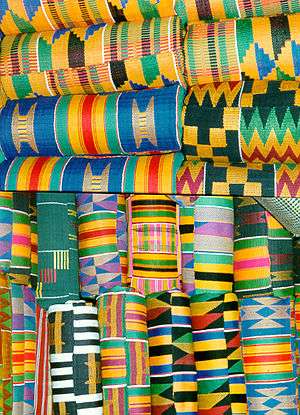Kente cloth

Kente cloth, known as nwentom in Akan, is a type of silk and cotton fabric made of interwoven cloth strips and is native to the Akan ethnic group of South Ghana.
Kente cloth has its origin in the Ashanti kingdom, and was adopted by people in Ivory Coast and many other West African countries. It is an Akan royal and sacred cloth worn only in times of extreme importance and was the cloth of kings. Over time, the use of kente became more widespread. However, its importance has remained and it is held in high esteem with Akans.
Kente is made in Akan lands such as Ashanti Kingdom, (Bonwire, Adanwomase, Sakora Wonoo, Ntonso in the Kwabre areas of the Ashanti Region) and among Akans. Kente is also produced by Akans in Ivory Coast. Lastly, Kente is worn by many other groups who have been influenced by Akans. It is the best known of all African textiles. Kente comes from the word kenten, which means basket in Akan dialect Asante. Akans refer to kente as nwentoma, meaning woven cloth.
The icon of African cultural heritage around the world, Akan kente is identified by its dazzling, multicolored patterns of bright colors, geometric shapes, and bold designs. Kente characterized by weft designs woven into every available block of plain weave is called adweneasa. The Akan people choose kente cloths as much for their names as their colors and patterns. Although the cloths are identified primarily by the patterns found in the lengthwise (warp) threads, there is often little correlation between appearance and name. Names are derived from several sources, including proverbs, historical events, important chiefs, queen mothers, and plants.
The Maroon people of Suriname in South America are the descendants of people who were brought from Africa as slaves after the mid-17th century and who escaped to live in the forests of the interior, eventually obtaining the right of self-government from the colonial powers.[1] The Pangi cloth made by the Maroons is a cotton fabric with multi-colored vertical and horizontal stripes, similar to West African kente cloth.[2]
Symbolic meanings of the colors in kente cloth
Meanings of the colors in kente cloth:[3]
- black—maturation, intensified spiritual energy
- blue—peacefulness, harmony and love
- green—vegetation, planting, harvesting, growth, spiritual renewal
- gold—royalty, wealth, high status, glory, spiritual purity
- grey—healing and cleansing rituals; associated with ash
- maroon—the color of mother earth; associated with healing
- pink—assoc. with the female essence of life; a mild, gentle aspect of red
- purple—assoc. with feminine aspects of life; usually worn by women
- red—political and spiritual moods; bloodshed; sacrificial rites and death.
- silver—serenity, purity, joy; associated with the moon
- white—purification, sanctification rites and festive occasions
- yellow—preciousness, royalty, wealth, fertility, beauty
Traditions
A variety of kente patterns have been invented, each of which has a certain concept or concepts traditionally associated with it.[4] For example, the Obaakofoo Mmu Man pattern symbolizes democratic rule; Emaa Da, novel creativity and knowledge from experience; and Sika Fre Mogya, responsibility to share monetary success with one's relations.[5]
Legend has it that kente was first made by two Akan friends who went hunting in an Asanteman forest found a spider making its web.[6] The friends stood and watched the spider for two days then returned home and implemented what they had seen. West Africa has had a cloth weaving culture for centuries via the stripweave method, but Akan history tells of the cloth being created independent of outsider influence.
Origin
The origin of kente is in the Akan empire of Bonoman. Most Akans migrated out of the area that was Bonoman to create various states.[7]
References
- ↑ "Obia Oso: An Ngjuka Maroon Shrine from Suriname". Yale Peabody Museum. Retrieved 2011-12-17.
- ↑ "The Maroon Community". Surinam Designz, Inc. Retrieved 2011-12-17.
- ↑ Kente Cloth." African Journey. projectexploration.org. 25 Sep 2007.
- ↑ Wisdom: Adinkra Symbols & Meanings. welltempered.net.
- ↑ G. F. Kojo Arthur and Robert Rowe (2001). "Akan Kente Cloths and Motifs". Akan Cultural Symbols Project. Marshall University. Archived from the original on 2010-01-07. Retrieved 2011-10-15.
- ↑ West African Wisdom: Adinkra Symbols & Meanings – Bibliography
- ↑ Kwasi Konadu, Kwasi Konadu, Indigenous medicine and knowledge in African society, Routledge, 2007. pp 30–31.
External links
African fabric and fashion

.ogv.jpg)


.svg.png)